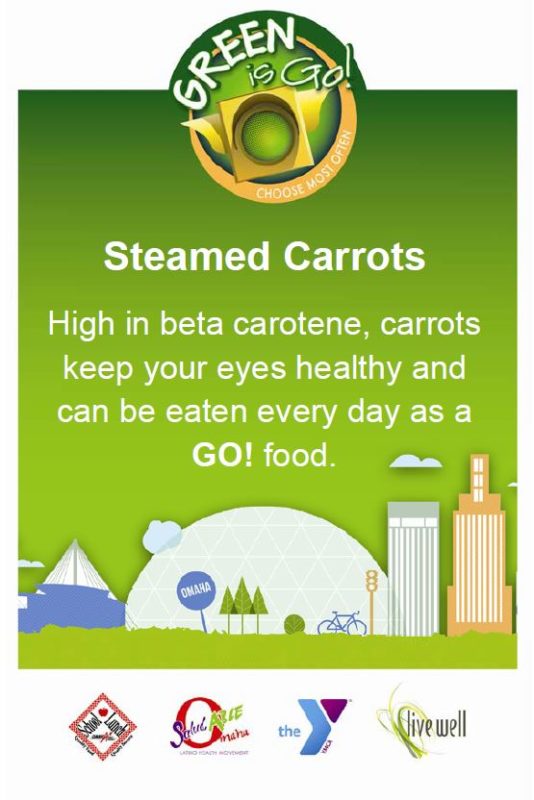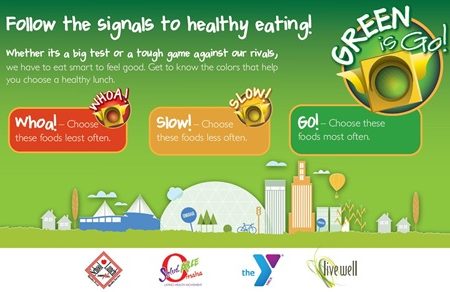
Share On Social!
Obesity rates have nearly doubled over the past 15 years in Nebraska. The youth obesity rate in Douglas County, which includes the state’s largest city, Omaha, is even higher (28%) than the state’s overall rate. A group of Latino youth advocates recognized obesity’s pervasiveness in their high-school ranks in Omaha and decided to help their peers improve their nutritional knowledge and make healthier food choices at school. This effort yielded a novel “Green is Go” marketing campaign that simultaneously highlights healthy food options in school cafeterias and stigmatizes less healthy options. Not only did the students conceptualize this campaign, they worked with school and other officials to get it implemented in their cafeteria.
EMERGENCE
Awareness: Omaha, Neb., has a burgeoning Latino community whose numbers nearly doubled from 2000 to 2010. But obesity rates in Omaha’s county, Douglas County, were higher than the state’s rate. A group of students of Omaha’s South High School recognized obesity’s pervasiveness among their peers and didn’t like seeing the problems it caused—sedentary lifestyles, more sickness, etc. The students, part of a Latino youth advocacy group forged to create a health movement in Omaha, called Saludable Omaha, decided to do something about the problem.
Learn: During meetings as part of Saludable Omaha, students began to discuss what change to make. The conversation soon focused on school lunch options. Students felt they didn’t know much about the nutritional value of the school lunch menu, available school snacks, or what items might constitute a balanced, healthy lunch. How would any students know what foods would benefit their bodies? To answer that question, Saludable Omaha youth created a survey to ask random students what healthy choices they were making and whether they were aware of healthy choices. The survey indicated students were generally unsure about what items were healthy choices at lunch.
Frame Issue: The Saludable Omaha youth believed they needed to educate their peers about what was being served in the cafeteria, and how to choose the healthiest items to provide the most nutrition for their bodies and prevent obesity. They decided to do this by adapting the widespread Green is Go system into a marketing campaign. Green is Go is a labeling method that labels foods based on their nutritional value, showing which foods should be eaten frequently, occasionally, and rarely. The students chose this method because it would be easy to understand for students and would clearly show their classmates what healthy options were available at school.
DEVELOPMENT
Education: The Saludable Omaha students spoke with their school’s cafeteria director and the school district’s nutrition director about their idea to implement this marketing campaign, and how this could help all students make better choices in the lunch line. They showed them their survey results, and spoke with them about how students need to be educated about nutrition, but in a visual and eye-catching way. The directors supported their marketing campaign, and were very excited to see that students wanted drive change, because parents or teachers were usually behind such changes.
Mobilization: While planning their campaign, Saludable Omaha students decided to involve other students at their school to help shape their campaign. A student leadership group, Characters in Action (CIA), supported the campaign. These two youth leadership programs came together to create the campaign posters, labels, and educate all their peers about healthy eating.
Debate: The Saludable Omaha and CIA students now had to figure out the best strategy to promote their campaign in front of students and effectively explain their message to other students. They decided on using point-of-sale signs at the checkout counters in lunch lines, along with posters to be displayed throughout the school explaining what the point-of-sale green, yellow, and red signs would mean. The combined group of students began designing posters, but needed nutritional information and facts to complete their marketing materials.
ENACTMENT

Activation: Saludable Omaha students brought in a nutritionist to explain the nutritional value of food served in the cafeteria. The nutritionist helped them examine the nutrition of current menu items. The students leaned on her expertise, and tips from the Center for Disease Control website, to finalize their campaign’s nutrition facts. Students also used interesting facts about foods or ingredients that in different meals so that they could put them onto different colored (green, yellow, or red) signs when that food was being served for lunch.
Frame Policy: The Saludable Omaha and CIA students began finalizing their lunch line and point-of-sale signs with facts for different foods featured on different colored signs. Green signs designated a healthy food that should be consumed often. Yellow signs showed foods with some nutritional value that should only be eaten on occasion. Red signs indicated a food with no nutritional value that should be chosen least often. The students also designed large posters to explain what Green is Go is and how people can use it to make smarter choices in the cafeteria.
Change: After presenting the finished posters and point-of-sale signs to the school cafeteria director and staff, they were given permission to begin the marketing campaign in the 2011-2012 school year.
IMPLEMENTATION
Implementation: The youth posted the explanatory marketing posters throughout South High School the hallways, lockers areas, and other places students would see them the most. With the help of the cafeteria staff, the youth began to put up the point-of-sale signs in the lunch line each day, with the food or ingredient on the sign corresponding to the meal being served. The point-of-sale signs were implemented gradually, first with just green signs, then the yellow signs, then all the sign colors together. To ensure the campaign would impact student meal and snack choices, Saludable Omaha and CIA students made sure that their posters and marketing materials were easy to see, visually appealing, and memorable.
Equity: After the marketing posters and point-of-sale signs had been posted, the Saludable Omaha students created a survey to see how students reacted to the marketing campaign. This survey was similar to the first survey, asking questions about the student’s healthy choices and how confident they felt about their knowledge of school lunch nutrition. After the Green is Go marketing campaign, students felt like they had more nutritional knowledge of what they were eating, and felt that they could now make educated choices about what to eat for lunch.
Sustainability: Although the students had created many point-of-sale signs and posters, the cafeteria staff could not keep up with posting new signs every day. To continue putting up nutritional facts of foods/ingredients that corresponded with each day’s meal, signs would continually need to be made and menus changed. To keep the nutrition educational aspect of the Green is Go marketing campaign and signs in the lunch line, new signs were made that offer general nutritional facts and tips for each category; Go, Slow, and Whoa. Although they had to switch to a more generic method, their campaign remains a success in educating students about available healthy choices. The change even inspired another school in the area to adopt the Green is Go campaign in their cafeteria!
This success story was produced by Salud America! with support from the Robert Wood Johnson Foundation.
The stories are intended for educational and informative purposes. References to specific policymakers, individuals, schools, policies, or companies have been included solely to advance these purposes and do not constitute an endorsement, sponsorship, or recommendation. Stories are based on and told by real community members and are the opinions and views of the individuals whose stories are told. Organization and activities described were not supported by Salud America! or the Robert Wood Johnson Foundation and do not necessarily represent the views of Salud America! or the Robert Wood Johnson Foundation.
ABOUT THE PROGRAM
Salud America! The RWJF Research Network to Prevent Obesity Among Latino Children is a national program of the Robert Wood Johnson Foundation. The program aims to educate researchers, decision-makers, community leaders, and the public in contributing toward healthier Latino communities and seeking environmental and policy solutions to the epidemic of Latino childhood obesity. The network is directed by the Institute for Health Promotion Research at the University of Texas Health Science Center at San Antonio.
For more information, visit http://www.salud-america.org.
By The Numbers
142
Percent
Expected rise in Latino cancer cases in coming years
This success story was produced by Salud America! with support from the Robert Wood Johnson Foundation.
The stories are intended for educational and informative purposes. References to specific policymakers, individuals, schools, policies, or companies have been included solely to advance these purposes and do not constitute an endorsement, sponsorship, or recommendation. Stories are based on and told by real community members and are the opinions and views of the individuals whose stories are told. Organization and activities described were not supported by Salud America! or the Robert Wood Johnson Foundation and do not necessarily represent the views of Salud America! or the Robert Wood Johnson Foundation.



